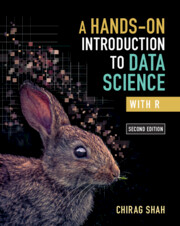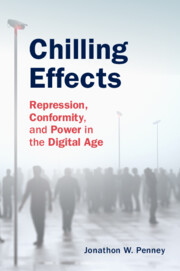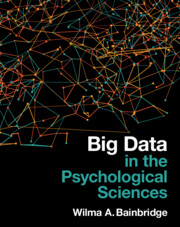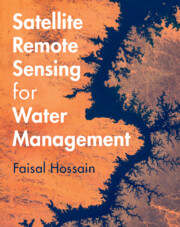Refine search
Actions for selected content:
303 results

A Hands-On Introduction to Data Science with R
- Coming soon
-
- Expected online publication date:
- January 2026
- Print publication:
- 31 January 2026
-
- Textbook
- Export citation

A Hands-On Introduction to Data Science with Python
- Coming soon
-
- Expected online publication date:
- December 2025
- Print publication:
- 22 January 2026
-
- Textbook
- Export citation
Chapter 2 - What Big Data Tells Us about American English Phonetics
-
-
- Book:
- Data-Intensive Investigations of English
- Published online:
- 03 December 2025
- Print publication:
- 18 December 2025, pp 20-47
-
- Chapter
- Export citation

Chilling Effects
- Repression, Conformity, and Power in the Digital Age
-
- Published online:
- 20 November 2025
- Print publication:
- 20 November 2025
New Technology and OB/HRM in China: Digital Methods for Organizational Research
-
- Journal:
- Management and Organization Review , First View
- Published online by Cambridge University Press:
- 07 November 2025, pp. 1-6
-
- Article
-
- You have access
- HTML
- Export citation
7 - Technology, Nudges, Reputation, and Voluntary Compliance
-
- Book:
- Can the Public be Trusted?
- Published online:
- 11 October 2025
- Print publication:
- 30 October 2025, pp 165-185
-
- Chapter
-
- You have access
- Open access
- HTML
- Export citation

Big Data in the Psychological Sciences
-
- Published online:
- 23 October 2025
- Print publication:
- 23 October 2025
-
- Textbook
- Export citation
1 - What Is Big Data?
-
- Book:
- Big Data in the Psychological Sciences
- Published online:
- 23 October 2025
- Print publication:
- 23 October 2025, pp 1-12
-
- Chapter
- Export citation

Satellite Remote Sensing for Water Management
-
- Published online:
- 10 October 2025
- Print publication:
- 04 September 2025
-
- Textbook
- Export citation
3 - The Data War
-
- Book:
- Killing the Messenger
- Published online:
- 05 September 2025
- Print publication:
- 25 September 2025, pp 51-61
-
- Chapter
-
- You have access
- Open access
- HTML
- Export citation
7 - Privacy, Big Data, and Free Speech
-
- Book:
- Killing the Messenger
- Published online:
- 05 September 2025
- Print publication:
- 25 September 2025, pp 146-163
-
- Chapter
-
- You have access
- Open access
- HTML
- Export citation
The current state of paediatric publishing utilising high-fidelity physiologic data streaming with sickbay or etiometry: a systematic review
-
- Journal:
- Cardiology in the Young / Volume 35 / Issue 9 / September 2025
- Published online by Cambridge University Press:
- 05 September 2025, pp. 1809-1814
-
- Article
- Export citation
4 - Introduction to Cloud Computing
-
- Book:
- Satellite Remote Sensing for Water Management
- Published online:
- 10 October 2025
- Print publication:
- 04 September 2025, pp 59-84
-
- Chapter
- Export citation
1 - Why Manage Water with Satellite Remote Sensing?
-
- Book:
- Satellite Remote Sensing for Water Management
- Published online:
- 10 October 2025
- Print publication:
- 04 September 2025, pp 1-17
-
- Chapter
- Export citation
Towards improving the information management of aircraft cabin retrofits by processing quantity-on-hand documents
-
- Journal:
- Proceedings of the Design Society / Volume 5 / August 2025
- Published online by Cambridge University Press:
- 27 August 2025, pp. 3201-3210
-
- Article
-
- You have access
- Open access
- HTML
- Export citation
Data-driven system modelling in the system generation engineering
-
- Journal:
- Proceedings of the Design Society / Volume 5 / August 2025
- Published online by Cambridge University Press:
- 27 August 2025, pp. 1111-1120
-
- Article
-
- You have access
- Open access
- HTML
- Export citation
Using statistical clustering of trajectory data to support analysis of subject movement in a virtual environment
-
- Journal:
- Proceedings of the Design Society / Volume 5 / August 2025
- Published online by Cambridge University Press:
- 27 August 2025, pp. 3361-3370
-
- Article
-
- You have access
- Open access
- HTML
- Export citation
Impact of the 2018 Western Japan Heavy Rain Disaster on Anti-influenza Virus Drug Prescribing: A Longitudinal Analysis Using the National Health Insurance Claims Database
-
- Journal:
- Disaster Medicine and Public Health Preparedness / Volume 19 / 2025
- Published online by Cambridge University Press:
- 07 August 2025, e223
-
- Article
- Export citation
Factors associated with drug–drug interactions involving citalopram in the UK Biobank
-
- Journal:
- BJPsych Open / Volume 11 / Issue 5 / September 2025
- Published online by Cambridge University Press:
- 01 August 2025, e166
-
- Article
-
- You have access
- Open access
- HTML
- Export citation
Truth Telling, Trust, and Just Intelligence Theory
-
- Journal:
- Ethics & International Affairs / Volume 39 / Issue 1 / Spring 2025
- Published online by Cambridge University Press:
- 22 July 2025, pp. 89-101
-
- Article
-
- You have access
- Open access
- HTML
- Export citation
